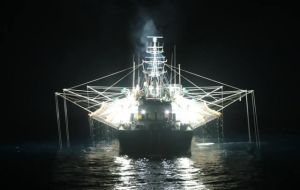MercoPress. South Atlantic News Agency
Falklands closes first Loligo season earlier; successful catch anticipated
 Dr Clausen explained Loligo are protected by not allowing fishing in the spawning grounds at any time – spatial management
Dr Clausen explained Loligo are protected by not allowing fishing in the spawning grounds at any time – spatial management  The cause of the closure of this season was the presence of, “high numbers of very small squid” migrating onto the feeding grounds where vessels fish. (Pic FIG)
The cause of the closure of this season was the presence of, “high numbers of very small squid” migrating onto the feeding grounds where vessels fish. (Pic FIG)  “These squid are the ones that go on to become the squid we fish in the second season so it’s in all of our interests, industry’s and Department, to protect them”
“These squid are the ones that go on to become the squid we fish in the second season so it’s in all of our interests, industry’s and Department, to protect them”  The department also began to see Illex “a voracious predator,” moving towards the Loligo box; “a long way south and east, further than they normally do. (Pic A.Henry)
The department also began to see Illex “a voracious predator,” moving towards the Loligo box; “a long way south and east, further than they normally do. (Pic A.Henry) The Falkland Islands Loligo (Falkland Calamari) fishery, which holds two seasons a year, closed its first season of 2021 early – the northern part of the box on April 14 and the south on April 28, three days before the planned last day of May 1.
Penguin News spoke to the Director of the FIG Natural Resources Department – under which fisheries is included – Dr Andrea Clausen, about the reasons an early closure of the season might occur and what it means.
“It’s absolutely not a bad sign Clausen began. “It’s not bad because we’re protecting the resource. We have a number of different measures to manage our resources here and the two largest are temporal and spatial.”
Dr Clausen explained Loligo are protected by not allowing fishing in the spawning grounds at any time – spatial management – and separately managing the fishery in real time. “For conservation reasons, we closed the fishery. “Because a squid only lives for 12 months, and we look to see the different sizes and maturities to see where they are, even on the feeding grounds, to ensure that we don’t fish the ones that we don’t want to. So that is temporal.”
The cause of the closure of this season was the presence of, “high numbers of very small squid” migrating onto the feeding grounds where vessels fish. These juvenile Loligo, of which the percentage of catch increased from 15% to 44% over a number of days, Doctor Clausen said, are part of another “cohort” of squid.
“These squid are the ones that go on to become the squid we fish in the second season so of course it’s in all of our interests, industry’s and [the Fisheries Department] as regulators, to protect those small squid.”
In addition to the movement of the immature squid into the feeding grounds Dr Clausen explained an additional factor for the early closure of the fishery.
The department began to see Illex “a voracious predator,” moving towards the Loligo box; “a long way south and east, further than they normally do.
“Although they’re both squid species Illex predate Loligo, and there was a concern that they might come into the Loligo box.”
Dr Clausen explained this is a proven concern, as in previous years there have been influxes of Illex which have significantly predated on the Loligo. In these scenarios measuring the biomass of squid in the area becomes difficult.
“Our stock assessment modeling becomes really difficult because we’re normally managing them with one serious predator, which is the fishing industry. To have two, and [Illex] are three times the size of a loligo.”
Dr Clausen said the Illex didn’t travel as far south as the department had worried they might.
Another of the primary conservation measures for the fishery, Dr Clausen said, was tracking the biomass level; “the amount of squid out there.”
The season needs to be closed, she said, when the biomass reaches the level which was needed to spawn and reproduce to ensure that the next year’s stock was sufficient. “That is 10,000 metric tons for the Loligo fishery.” Dr Clausen stated.
“It has been closed in the past when stocks have reached that level, and it’s a real time depletion model that is live and we run twice a week, so we monitor all the time what’s going on.”
Dr Clausen noted the biomass being still high when the fishery was being closed. “It was around 60 to 70,000 metric tons, so one might say: ‘Well why don’t you just let them carry on fishing?’ Well, we have to balance up lots of different factors when you make these decisions. We also balanced up that it has actually been a very, incredibly, successful fishing season.
“I’m waiting for the final figures to come in, but I believe we’ve just pipped in 50,000 metric tons... Just shy of what we caught in the whole of 2020.”




Top Comments
Disclaimer & comment rulesCommenting for this story is now closed.
If you have a Facebook account, become a fan and comment on our Facebook Page!